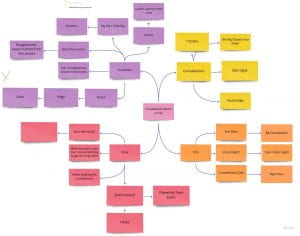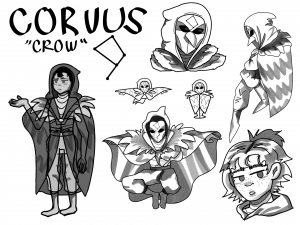Constellation World – Week 2
In the first group I was sorted into, we worked together to brainstorm ideas for a world to create. In this group we had myself, Dan, Wren, Darren and Nathan. We had many small ideas, and a few big ideas. We brought the big ideas into another brainstorm and figured what we could develop from them. We eliminated at few and chose the Constellation world idea.

 After choosing our idea, we discussed what we wanted this world to include and what story it should tell. The constellation world is based on a planet far from earth. Many civillians are born or equipped with the power and soul of a constellation. We created a few characters based on constellations such as Big Dipper, Corvus and Orion. These people try to protect their sacred soul while humans come from earth to try and take it away from them as they want more control and power. As soon as someone loses their constellation soul, they forget who they were. These people also have constellation tattoos or markings on their body to represent their power.
After choosing our idea, we discussed what we wanted this world to include and what story it should tell. The constellation world is based on a planet far from earth. Many civillians are born or equipped with the power and soul of a constellation. We created a few characters based on constellations such as Big Dipper, Corvus and Orion. These people try to protect their sacred soul while humans come from earth to try and take it away from them as they want more control and power. As soon as someone loses their constellation soul, they forget who they were. These people also have constellation tattoos or markings on their body to represent their power.
As part of our week 2 homework, we designed 12 thumbnails of composition studies based on our world theme. while doing this we could ideate how we wanted our world to look etc. landscapes, wildlife, environment and atmosphere. In addition we were to consider using one, two and three-point perspectives.
Between my group and I, we started designing our first few characters to achieve an overall look of the world theme. I chose to focus on the character Corvus. I researched a bit about the constellation and researched some ‘crow-like’ designs for this character.
I also made my own take on the other two characters designed by my teammates, Wren and Dan. They are called Big Dipper and Orion. Although we were fond of these designs, they are just our first drafts. Overtime I would say our designs may change up a little. Especially when the groups switch up. New people will come with new ideas and therefore more development blossoms.







 I drew two-point perspective line-work over a shot from Spiderman-Into the Spider-verse. It was quite hard to get an idea of how this perspective worked as its shot from a low birds-eye view, though I managed to capture the building, path and road in the perspective lines. It’s a very quick shot in the movie but so much is happening in it. Etc. the crowds, the traffic, the lights.
I drew two-point perspective line-work over a shot from Spiderman-Into the Spider-verse. It was quite hard to get an idea of how this perspective worked as its shot from a low birds-eye view, though I managed to capture the building, path and road in the perspective lines. It’s a very quick shot in the movie but so much is happening in it. Etc. the crowds, the traffic, the lights.








